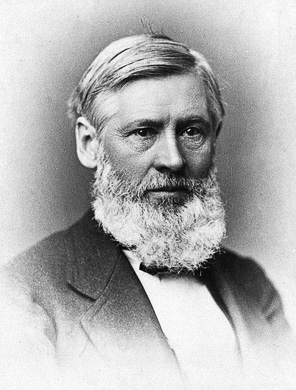BOTANY FOR YOUNG PEOPLE AND COMMON SCHOOLS
How Plants Grow
A Simple Introduction to Structural Botany
by Asa Gray
Originally published in 1858 and now in the public domain.
CHAPTER II.
HOW PLANTS ARE PROPAGATED OR MULTIPLIED IN NUMBERS.
SECTION III. -- Flowers (page 3 of 3).
1. Their Arrangement on the Stem. CLICK HERE
2. Forms and Kinds of Flowers (a). CLICK HERE
§ 2. Forms and Kinds of Flowers (b).
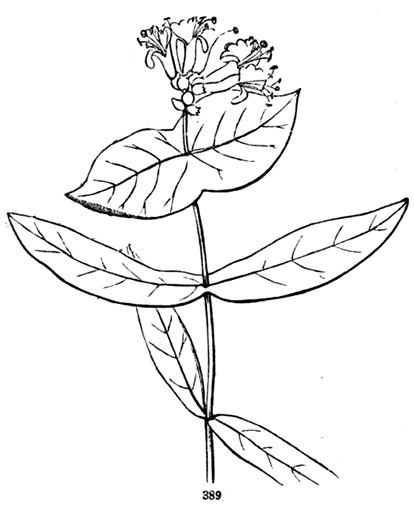
So far, most of the examples in this section are from
211. Flowers with the parts all distinct, that is, of separate pieces: the calyx of distinct sepals, the corolla of distinct petals (i.e., Polypetalous), the stamens distinct (separate, &c.), and all the parts growing in regular order out of the receptacle, in other words, inserted on the receptacle. These are the simplest or most natural flowers, the parts answering to so many leaves on a short branch.
But as in Honeysuckles (Fig. 389) the leaves of the same pair are often found grown together into one, so in blossom-leaves, there are plenty of
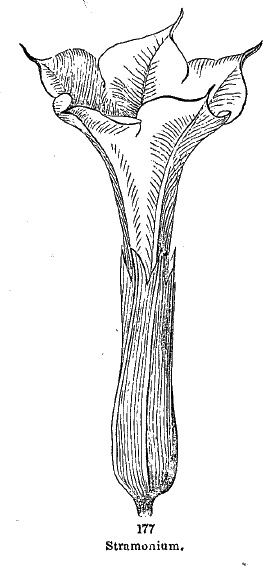
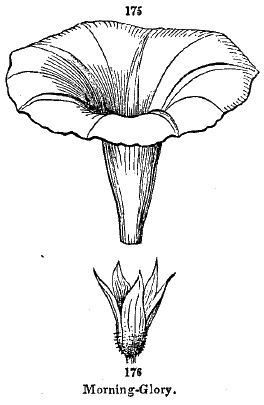
212. Flowers with their parts united or grown together. The flower of Morning-Glory (Fig. 4) is a good example. Here is the calyx of five separate leaves or sepals (Fig. 176); but in the corolla (Fig. 175) the five petals are completely united into a cup, just as the upper leaves of Honeysuckles are into a round plate.
Then, in Stramonium (Fig. 177), the five sepals also are united or grown together almost to their tips into a cup or tube; and so are the five petals likewise, but not quite to their tips; and the five teeth or lobes (both of the calyx and of the corolla) plainly show how many leaves there really are in each set.
When this is so in the corolla, it forms what is called a
213. Monopetalous corolla; i.e., a corolla of one piece.
It is so called, whether it makes a cup or tube with the border entire, as in Morning-Glory (Fig.175), or with the border lobed, that is, the tips of the petals separate, as in Stramonium (Fig.177), or even if the petals are united only at the bottom, as in the Potato-blossom (Fig. 182).
The same may be said of a calyx when the sepals are united into a cup, only this is called Monosepalous.
A monopetalous corolla (and so of a calyx) is generally distinguishable into two parts, namely, its Tube or narrow part below, and its Border or Limb, the spreading part above.
It is regular when all sides and lobes of it are alike, as in Fig. 175, 177, &c.
It is irregular when the sides or parts are different or unequal in size or shape, as in Sage, Dead-Nettle (Fig. 181), the common Honeysuckle, &c.
It is
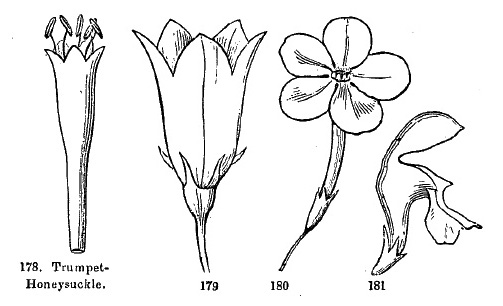
Tubular, when long and narrow without a conspicuous border, as in Fig. 178, or
Trumpet-shaped; tubular, gradually enlarging upwards, as in Trumpet-Creeper and Trumpet-Honeysuckle (Fig. 178);
Funnel-shaped or Funnel-form (like a funnel or tunnel); when the tube opens gradually into a spreading border, as in Morning-Glory (Fig. 175) and Stramonium (Fig. 177);
Bell-shaped or Campanulate; when the tube is wide for its length and the border a little spreading, like a bell, as in Harebell (Fig. 179).
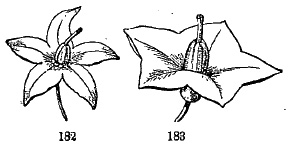
Salver-shaped, when a slender tube spreads suddenly into a flat border, as in Phlox (Fig. 180)
Wheel-shaped or Rotate, same as salver-shaped, with the tube very short or none, as in the corolla of the Potato (Fig. 182) and the Nightshade (Fig. 183).
Labiate or Two-lipped, when the border divides into two parts, or lips, au upper and a lower (sometimes likened to those of an animal with gaping mouth), as in Sage, Dead-Nettle (Fig. 181), and the like. This is one of the irregular forms of monopetalous corolla, and the commonest.
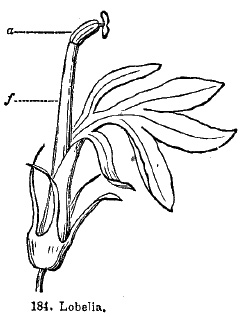
214. Stamens united are also common. They may be united by their filaments or by their anthers.
In the Cardinal-flower (Fig. 184) and other Lobelias, both the anthers (a) and the filaments (f) are united into a tube. So also in the Pumpkin and Squash.
Botanists use the following terms to express the different ways in which stamens may be connected. They are
Syngenesious, when the anthers are united into a ring or tube, as in Lobelia (Fig. 184 a), and in the Sunflower and all that family.
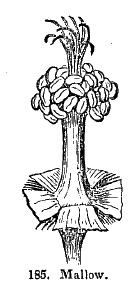
Monadelphous (i.e., in one brotherhood), when the filaments are united all into one set or tube, as in Lobelia (Fig. 184 f), and the Mallow Family (Fig. 185); also in Passion-flowers and Lupines (Fig. 187).
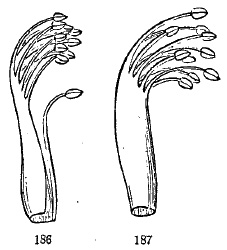
Diadelphous (in two brotherhoods), when the filaments are united in two sets. Fig. 186 shows this in the Pea, and the like, where nine stamens are combined in one set and one stamen is left for the other.
Triadelphous (in three brother hoods), when the filaments are united or collected in three sets, as in the Common St. John's-wort or Hypericum (Fig. 297), and
Polyadelphous (in many brotherhoods), when combined in more than three sets, as in some St. John's-worts.
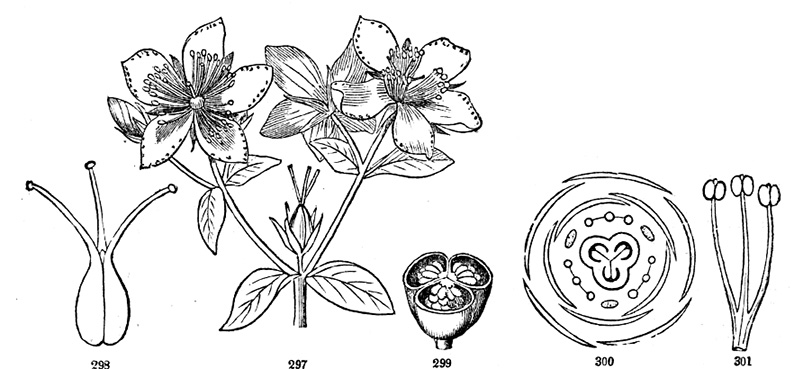
215. Pistils united are very common. Two, three, four, or more grow together at the time of their formation and make a Compound Pistil. Indeed, wherever there is a single pistil to a flower, it is much oftener a compound pistil than a simple one.
But of course, when the pistils of a flower are more than one, they are all simple.
Pistils may be united in every degree, and by their ovaries only, by their styles only (as they are slightly in Prickly-Ash), or even by their stigmas only (as in Milkweeds), or by all three. But more commonly the ovaries are united into one Compound Ovary, while the styles or stigmas are partly separate or distinct.
Three degrees of union are shown in these figures.
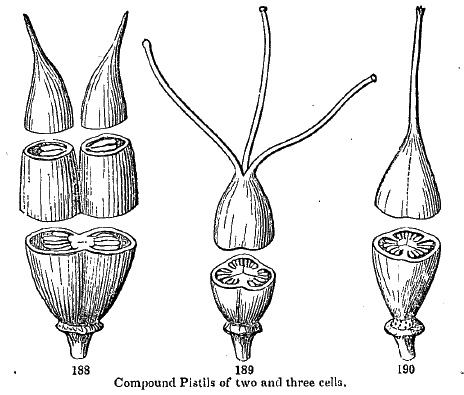
Fig. 188, two pistils of a Saxifrage, their ovaries united only part way up (cut across both above and below).
Fig. 189, pistil of Common St. John's-wort, plainly composed of three simple ones, with their ovaries completely united, while their slender styles are separate.
Fig. 190, same of Shrubby St. John's-wort, like the last, but with the three styles also grown together into one, the little stigmas only separate; but as it gets older this style generally splits down into three, and when the pod is ripe it also splits into three, plainly showing that this compound pistil consists of three united into one.
On turning now to Fig. 8 and Fig. 10 to 12 on the same page, it will be seen that the pistil in Morning-Glory and in Lily is a compound one, made of three united even to their stigmas. This is shown externally, by the stigma being somewhat three-lobed in both. And it becomes perfectly evident on cutting the ovary in two, bringing to view the three cells (Fig. 12, as in Fig. 189, 190), each answering to one simple ovary.
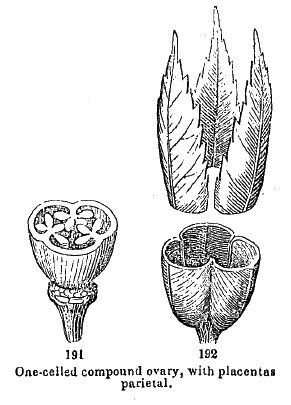
216. So compound ovaries generally have as many cells as there are simple pistils or pistil-leaves in their composition; and have the placentas (199) bearing the seeds all joined in the centre: that is, the placentas or compound placenta in the axis.
But sometimes the partitions or divisions between the cells vanish, as in Pinks; then the compound pistil is only one-celled.
And sometimes there never were any partitions, but the pistil was formed of two, three, or more open pistil-leaves grown together from the first by their edges, just as petals join to make a monopetalous corolla. Then the ovules or seeds, or the placentas that bear them, are parietal, that is, are borne on the parietes or wall of the ovary.
Fig. 191 is the lower part of a compound ovary, with three parietal placentas or seed-bearing lines; and Fig. 192 is a diagram, to explain how such a pistil is supposed to be made of three leaves united by their edges, and these edges bearing the ovules or seeds.
217. Flowers with one set of Organs united with another. The natural way is, for all the parts to stand on the receptacle or end of the flower-stalk, the stem-part of the blossom (191). Then the parts are said to be free, or to be inserted on the receptacle.
So it is in the Buttercup, Lily, Trillium (Fig. 162), Flax, &c.
But in many flowers one set of organs grows fast to another set, or, as we say, is inserted on it. For instance, we may have the Petals and Stamens inserted on the Calyx, as in the Cherry and all the Rose family.
Fig. 193 is a flower of a Cherry, cut through the middle lengthwise, to show the petals and stamens growing on the tube or cup of the calyx. The meaning of it is that all these parts have grown together from their earliest formation.
Next we may have the
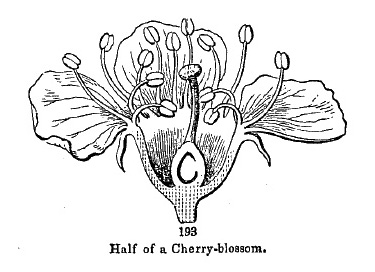
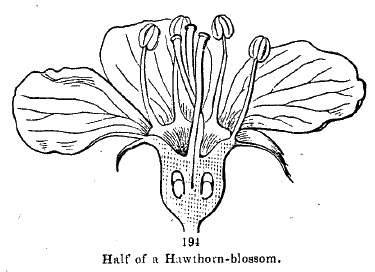
Calyx cohering or grown fast to the Ovary, or at least its cup or lower part grown to the ovary, and forming a part of the thickness of its walls, as in the Currant and Gooseberry, the Apple and Hawthorn.
Fig. 194 is a flower of Hawthorn cut through lengthwise to show this.
In such cases all other parts of the blossom appear to grow on the ovary. So the ovary is said to be inferior, or, which is the same thing, the calyx (i.e., its lobes or border) and the rest of the blossom, superior. Or else we say "calyx coherent with the ovary," which is best, because it explains the thing.
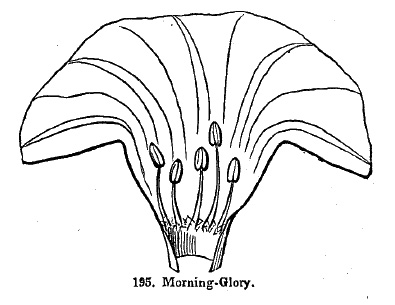
Stamens inserted on the Corolla. The stamens and the corolla generally go together. And when the corolla is of one piece (i.e., monopetalous, 213), the stamens almost always adhere to it within, more or less, that is, are borne or "inserted on the corolla."
Fig. 195 is the corolla of Morning-Glory laid open, to show the stamens inserted on it, i.e., grown fast to it, towards the bottom.
We may even have the
Stamens inserted on the Style, that is, united with it even up to the stigma. It is so in the Orchis family.
218. Gymnospermous or Open and Naked-seeded Pistils. This is the very peculiar pistil which belongs to Pines, Spruces, Cedars, and all that family of plants; and it is the simplest of all. For here the pistil is an open leaf or scale, bearing two or three ovules on its upper or inner surface. Each scale of a Pine-cone is an open pistil, and the ovules, instead of being enclosed in an ovary which forms a pod are naked and exposed to the pollen shed by the stamen-bearing flowers, which falls directly upon them.
Fig. 196 is a view of the upper side of an open pistil or scale from a forming Larch-cone at flowering-time, showing the two ovules borne on the face of it, one on each side near the bottom.
Fig. 197 is the same grown larger, the ovules becoming seeds. When ripe and dry, the scales turn back, and the naked seeds peel off and fall away.
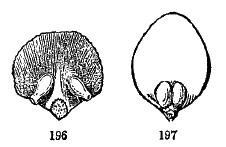
219. Plants which have such open scales for pistils accordingly take the name of
GYMNOSPERMOUS or Naked-seeded. The Pine family is the principal example of the kind. All other Flowering plants are
ANGIOSPERMOUS, that is, have their ovules and seeds produced in a seed-vessel of some sort.
Analysis of the Section.
211. Flowers with the parts distinct. 212. With their parts grown together. 213. Monopetalous corolla, &c., its varieties in form. 214. Stamens united; syngenesious, monadelphous; diadelphous, triadelphous, and polyadelphous. 215. Pistils united into a Compound Pistil: illustrations. 216. Those with two or more cells and placentas in the centre; of one cell with placentas parietal or on the walls.
217. Flowers with one set of organs united with another; as petals and stamens with the calyx; the tube or cup of the calyx with the ovary; stamens with the corolla; or with the style.
218, Gymnospermous or Naked-seeded Pistil of Pines, &c. 219. Division of plants on this account,

